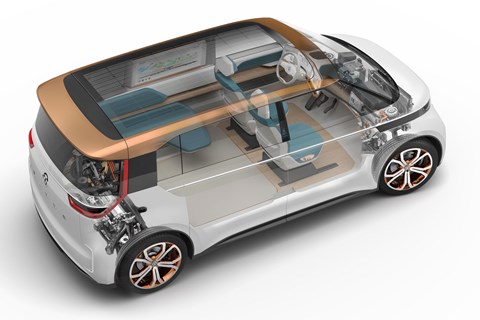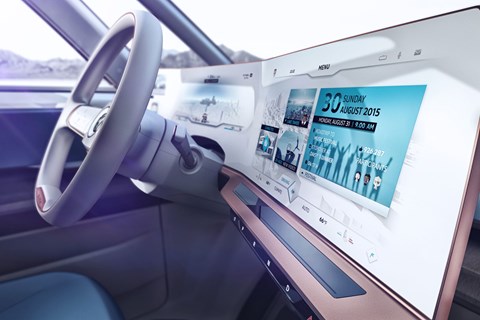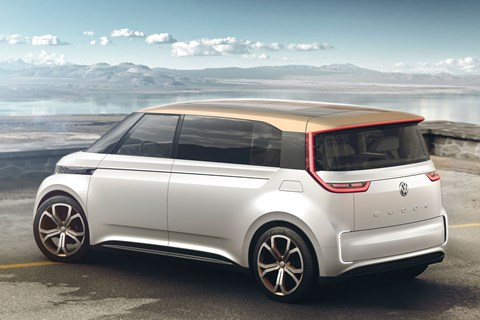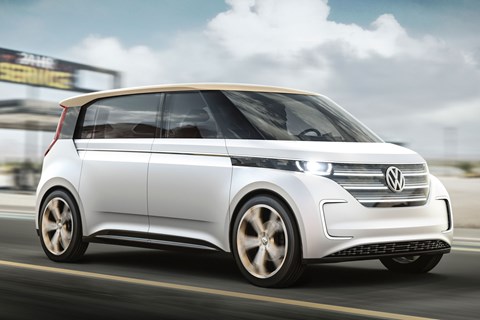► New VW Budd-E unveiled at CES 2016
► Features new modular electric platform
► EV concept offers a 373-mile range
Ever fancied a classic Volkswagen campervan but not been able to stomach the thought of dealing with that archaic flat-four and the ever-present threat of rust? Fear not, as Volkswagen may have just the answer.
The new VW BUDD-e, revealed at the 2016 Consumer Electronics Show, is thought to preview a production version of a new ‘Microbus’, set to go on sale in 2017.
VW’s retro-styled BUDD-e concept is underpinned by the company’s new Modular Electric Toolkit platform, dubbed MEB. It’s got two motors, four-wheel drive and packs a 101kWh battery that grants it a claimed range of 373 miles.
The BUDD-e is the first concept to utilise the new platform, which offers a host of benefits. It also packs a range of advanced features, including seat-specific voice controls.
So what’s this new electric platform about?

The MEB platform is a big change for VW. Whereas its production electric cars to date have been conventional models retrofitted with electric motors and battery packs, the MEB is designed with electric power in mind.
Consequently, it’s much more appropriately configured, with the batteries laid out below the floor and compact drive units at each end. This boosts interior space, both for passengers and luggage, considerably, while its modular nature makes it easy to adapt for different body styles or powertrain layouts.
With an electric motor on each axle, it also benefits from four-wheel drive, making it more appealing to many a buyer and better suited to harsher climates. VW has revealed a top speed of 93mph, but no 0-62mph times have been published – but you can expect it to be pretty swift off the mark.
The 101kWh battery reputedly grants the BUDD-e a range of 373 miles, which would be more than enough for the majority of journeys. Charging can be done via a plug or inductive panel, the latter of which would minimise hassle.
VW also says that, by the end of 2019, the batteries could be charged to 80 percent in around 15 minutes. That would make electric motoring far more viable for many drivers.
That’s more like it. What about the other features?

There’s a whole host of neat touches dotted throughout the BUDD-e, all of which would likely make it into future production cars. It’s got a large, customisable instrument panel, touch and gesture controls, and more natural voice controls.
For example, a passenger sat in the rear seat could say “I’m too hot,” and the BUDD-e would respond by dropping the temperature in that zone.
There’s a host of connected functionality, too. The VW can access your home or office’s air-con system in order to get the temperature right before you arrive, or turn the lights on as you pull into your parking space.
Its ‘Home-Net don’t forget’ list also allows you to note what’s been put in the car and if it’s still there. This allows the VW to prompt you with appropriate reminders. If it’s raining, it will notify you that there’s still an umbrella in the car. Or, if you walk out and leave your tablet behind, it will alert you via your phone or smartwatch.
As with many more recent offerings, the BUDD-e will feature gesture controls for access. Wave a foot under the tailgate and it’ll open. Unlike current examples, however, the VW will project a laser outline to help you gesture in the correct place – so no more blindly waving your foot or hand around in vain.
Will this ever see the light of day in production form?

It certainly appears that way, with a production version mooted for 2017, although you can expect some of the concept’s extravagant features and tech to be toned down a little for production.
VW’s been toying with the idea of a car like this for a while, with similar concepts including the Bulli of 2011, but the new MEB platform appears to have been the catalyst to push the project forwards.
The concept’s bigger than a Touran but smaller than a Multivan, so it should slot into the company’s existing range neatly. VW’s also been busy submitting patents regarding both the classic Type 2 and T25, suggesting it’s looking to protect more than just a concept.
Pricing has yet to be announced but, in this configuration, it would likely be quite expensive. Consequently VW may offer conventional petrol or diesel versions, helping keep the list price down, or less costly examples with single electric motors and a smaller battery pack.
MEB-derived vehicles may also be in the works for Audi, potentially as a follow-up to the A2. Spreading the cost of the platform would cut costs, but it’s likely the exteriors would be dramatically different in order to distinguish each offering.
